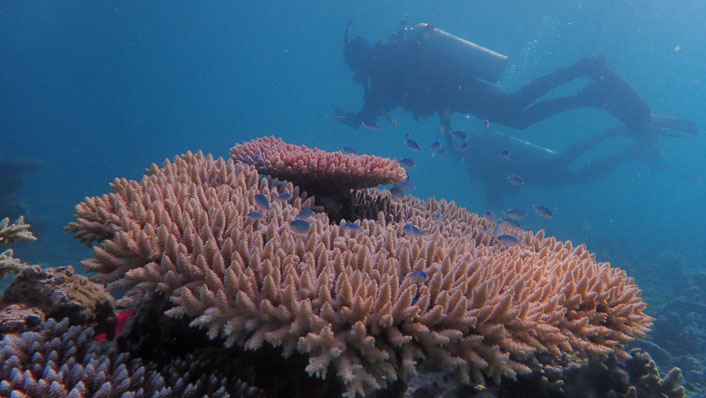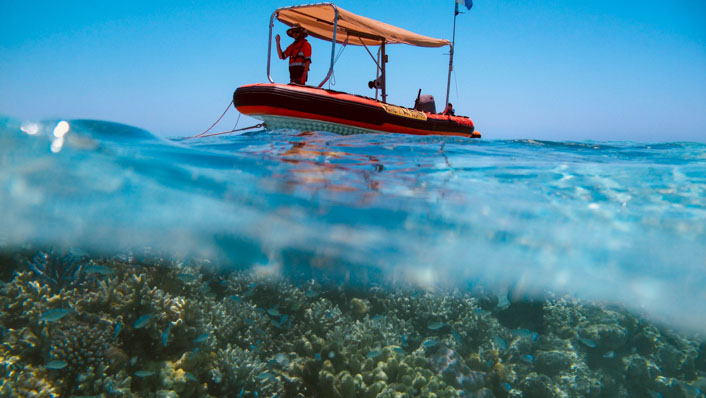Naturally fluctuating temperatures on coral reefs caused by tides, waves and currents can bring relief from marine heatwaves and may even help corals adapt to higher temperatures, a new study by Australian Institute of Marine Science (AIMS) and the (UWA) scientists has found.
Dr Camille Grimaldi and a team of researchers studied Mermaid Reef in the Rowley Shoals, offshore from Broome in north-Western Australia, for almost a year to understand more about how water flow affects temperature and coral bleaching risk in different parts of the remote atoll.
Bleaching is a coral’s response to heat stress, causing them to turn pale or white after they expel the algae which gives them their colour and provides them with food. While corals can recover, bleaching may result in reduced growth, limited reproduction, increased disease risk and even death. Climate change is driving the marine heatwaves which cause coral bleaching.
Located on the edge of the continental shelf, Mermaid Reef is part of a system known for its healthy and resilient coral reef habitat. This system has not experienced any major coral bleaching events since the mid-1990s.

Dr Grimaldi said they found some significant temperature changes in different areas of Mermaid Reef occurring in timescales from a few hours to weeks and caused by tides of up to three metres and large waves of up to two metres.
“We found that Mermaid Reef is a very lively place in some areas and quieter in others in terms of oceanographic processes like tides, currents and waves,” said Dr Grimaldi.
“Calm areas of the reef such as the lagoon are poorly connected to offshore waters, which provide little cooling to these areas. Other parts of the reef, like the slopes and flats, are exposed to tides and waves which increases the connection with cooler offshore waters. This has contributed to changing the reef’s temperatures in those areas significantly.
“Given the future trajectory of coral reefs under a warming climate, understanding this natural variability at Mermaid Reef will help us to identify environmental conditions that promote coral reef resilience and recovery more widely. This is pivotal to advancing our ability to conserve and manage coral reefs around the world.
“As the planet warms, reefs with the best chance of survival are likely to be the ones that are better connected to offshore ocean waters through the currents created by tides and waves. This is where we could be focusing conservation efforts.”
To understand how water flow controls reef temperatures and affects reef health, the researchers deployed a series of instruments in the waters surrounding Mermaid Reef atoll, including temperature and velocity sensors to track the strength of incoming waves and tides.

They found that because of the large tidal ranges, tidal flows were responsible for temperature changes occurring over just a matter of hours (up to 5.6°C in an hour), in locations separated by just a few hundred metres.
The resulting flow from the waves at Mermaid Reef also led to cooling over several days to weeks, suggesting that waves could provide relief from thermal stress over longer periods of time.
“This is important because several studies have suggested that temperature fluctuations over hourly or shorter timescales can expose corals to stressful temperatures for periods short enough to avoid coral mortality, but long enough to drive adaptation,” added Dr Grimaldi.
“Understanding finer scale temperature variations and their drivers at Mermaid Reef is important given that most satellite sea surface temperature (SST) measurements – the standard tool used by managers to monitor reef temperatures – are too coarse to pick up the temperature variabilities we recorded.”
A paper on these findings has been published in the journal Coral Reefs. It can be accessed here: .
AIMS is also studying temperature variations in areas of the Great Barrier Reef, as part of the (Ecological Intelligence for Reef Restoration) project.
This paper stems from the which is proudly supported by Santos as part of the company’s commitment to better understand WA’s marine environment.
About Mermaid Reef
Mermaid Reef is part of the Rowley Shoals, a group of isolated coral reefs located 270 miles off Broome on the edge of Australia’s continental shelf. Mermaid Reef is designated as a Commonwealth Marine Park and ³Ô¹ÏÍøÕ¾ Park Zone, meaning that fishing is not permitted there.
The Rowley Shoals are known for their healthy and resilient coral reef habitat. They are regarded as one of the world’s healthiest reef systems. They have not experienced any recent coral bleaching events contrary to most coral reefs around the world.
The Rowley Shoals are thought to be part of the living remnants of an ancient west coast coral reef system that mirrored the Great Barrier Reef.
Feature image: Mike Cuttler






